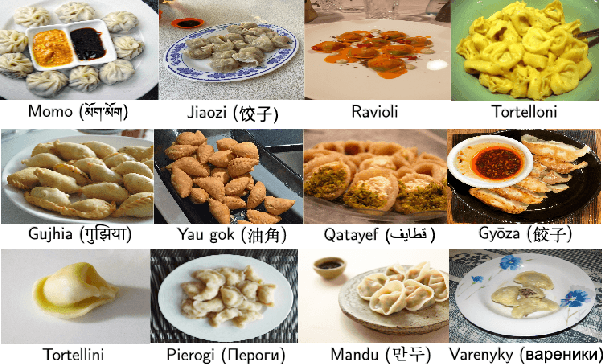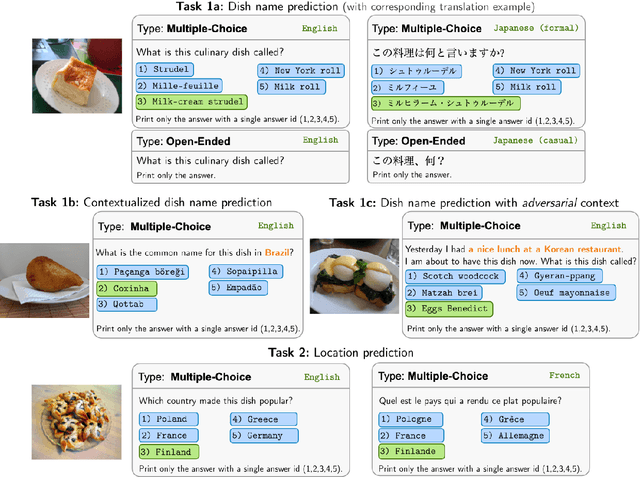David Ifeoluwa Adelani
Lugha-Llama: Adapting Large Language Models for African Languages
Apr 09, 2025Abstract:Large language models (LLMs) have achieved impressive results in a wide range of natural language applications. However, they often struggle to recognize low-resource languages, in particular African languages, which are not well represented in large training corpora. In this paper, we consider how to adapt LLMs to low-resource African languages. We find that combining curated data from African languages with high-quality English educational texts results in a training mix that substantially improves the model's performance on these languages. On the challenging IrokoBench dataset, our models consistently achieve the best performance amongst similarly sized baselines, particularly on knowledge-intensive multiple-choice questions (AfriMMLU). Additionally, on the cross-lingual question answering benchmark AfriQA, our models outperform the base model by over 10%. To better understand the role of English data during training, we translate a subset of 200M tokens into Swahili language and perform an analysis which reveals that the content of these data is primarily responsible for the strong performance. We release our models and data to encourage future research on African languages.
SemEval-2025 Task 11: Bridging the Gap in Text-Based Emotion Detection
Mar 10, 2025Abstract:We present our shared task on text-based emotion detection, covering more than 30 languages from seven distinct language families. These languages are predominantly low-resource and spoken across various continents. The data instances are multi-labeled into six emotional classes, with additional datasets in 11 languages annotated for emotion intensity. Participants were asked to predict labels in three tracks: (a) emotion labels in monolingual settings, (b) emotion intensity scores, and (c) emotion labels in cross-lingual settings. The task attracted over 700 participants. We received final submissions from more than 200 teams and 93 system description papers. We report baseline results, as well as findings on the best-performing systems, the most common approaches, and the most effective methods across various tracks and languages. The datasets for this task are publicly available.
BRIGHTER: BRIdging the Gap in Human-Annotated Textual Emotion Recognition Datasets for 28 Languages
Feb 17, 2025Abstract:People worldwide use language in subtle and complex ways to express emotions. While emotion recognition -- an umbrella term for several NLP tasks -- significantly impacts different applications in NLP and other fields, most work in the area is focused on high-resource languages. Therefore, this has led to major disparities in research and proposed solutions, especially for low-resource languages that suffer from the lack of high-quality datasets. In this paper, we present BRIGHTER-- a collection of multilabeled emotion-annotated datasets in 28 different languages. BRIGHTER covers predominantly low-resource languages from Africa, Asia, Eastern Europe, and Latin America, with instances from various domains annotated by fluent speakers. We describe the data collection and annotation processes and the challenges of building these datasets. Then, we report different experimental results for monolingual and crosslingual multi-label emotion identification, as well as intensity-level emotion recognition. We investigate results with and without using LLMs and analyse the large variability in performance across languages and text domains. We show that BRIGHTER datasets are a step towards bridging the gap in text-based emotion recognition and discuss their impact and utility.
Warmup Generations: A Task-Agnostic Approach for Guiding Sequence-to-Sequence Learning with Unsupervised Initial State Generation
Feb 17, 2025Abstract:Traditional supervised fine-tuning (SFT) strategies for sequence-to-sequence tasks often train models to directly generate the target output. Recent work has shown that guiding models with intermediate steps, such as keywords, outlines, or reasoning chains, can significantly improve performance, coherence, and interpretability. However, these methods often depend on predefined intermediate formats and annotated data, limiting their scalability and generalizability. In this work, we introduce a task-agnostic framework that enables models to generate intermediate "warmup" sequences. These warmup sequences, serving as an initial state for subsequent generation, are optimized to enhance the probability of generating the target sequence without relying on external supervision or human-designed structures. Drawing inspiration from reinforcement learning principles, our method iteratively refines these intermediate steps to maximize their contribution to the final output, similar to reward-driven optimization in reinforcement learning with human feedback. Experimental results across tasks such as translation, summarization, and multi-choice question answering for logical reasoning show that our approach outperforms traditional SFT methods, and offers a scalable and flexible solution for sequence-to-sequence tasks.
AfriHate: A Multilingual Collection of Hate Speech and Abusive Language Datasets for African Languages
Jan 15, 2025



Abstract:Hate speech and abusive language are global phenomena that need socio-cultural background knowledge to be understood, identified, and moderated. However, in many regions of the Global South, there have been several documented occurrences of (1) absence of moderation and (2) censorship due to the reliance on keyword spotting out of context. Further, high-profile individuals have frequently been at the center of the moderation process, while large and targeted hate speech campaigns against minorities have been overlooked. These limitations are mainly due to the lack of high-quality data in the local languages and the failure to include local communities in the collection, annotation, and moderation processes. To address this issue, we present AfriHate: a multilingual collection of hate speech and abusive language datasets in 15 African languages. Each instance in AfriHate is annotated by native speakers familiar with the local culture. We report the challenges related to the construction of the datasets and present various classification baseline results with and without using LLMs. The datasets, individual annotations, and hate speech and offensive language lexicons are available on https://github.com/AfriHate/AfriHate
AFRIDOC-MT: Document-level MT Corpus for African Languages
Jan 10, 2025



Abstract:This paper introduces AFRIDOC-MT, a document-level multi-parallel translation dataset covering English and five African languages: Amharic, Hausa, Swahili, Yor\`ub\'a, and Zulu. The dataset comprises 334 health and 271 information technology news documents, all human-translated from English to these languages. We conduct document-level translation benchmark experiments by evaluating neural machine translation (NMT) models and large language models (LLMs) for translations between English and these languages, at both the sentence and pseudo-document levels. These outputs are realigned to form complete documents for evaluation. Our results indicate that NLLB-200 achieved the best average performance among the standard NMT models, while GPT-4o outperformed general-purpose LLMs. Fine-tuning selected models led to substantial performance gains, but models trained on sentences struggled to generalize effectively to longer documents. Furthermore, our analysis reveals that some LLMs exhibit issues such as under-generation, repetition of words or phrases, and off-target translations, especially for African languages.
Fleurs-SLU: A Massively Multilingual Benchmark for Spoken Language Understanding
Jan 10, 2025Abstract:While recent multilingual automatic speech recognition models claim to support thousands of languages, ASR for low-resource languages remains highly unreliable due to limited bimodal speech and text training data. Better multilingual spoken language understanding (SLU) can strengthen massively the robustness of multilingual ASR by levering language semantics to compensate for scarce training data, such as disambiguating utterances via context or exploiting semantic similarities across languages. Even more so, SLU is indispensable for inclusive speech technology in roughly half of all living languages that lack a formal writing system. However, the evaluation of multilingual SLU remains limited to shallower tasks such as intent classification or language identification. To address this, we present Fleurs-SLU, a multilingual SLU benchmark that encompasses topical speech classification in 102 languages and multiple-choice question answering through listening comprehension in 92 languages. We extensively evaluate both end-to-end speech classification models and cascaded systems that combine speech-to-text transcription with subsequent classification by large language models on Fleurs-SLU. Our results show that cascaded systems exhibit greater robustness in multilingual SLU tasks, though speech encoders can achieve competitive performance in topical speech classification when appropriately pre-trained. We further find a strong correlation between robust multilingual ASR, effective speech-to-text translation, and strong multilingual SLU, highlighting the mutual benefits between acoustic and semantic speech representations.
AfriHG: News headline generation for African Languages
Dec 28, 2024Abstract:This paper introduces AfriHG -- a news headline generation dataset created by combining from XLSum and MasakhaNEWS datasets focusing on 16 languages widely spoken by Africa. We experimented with two seq2eq models (mT5-base and AfriTeVa V2), and Aya-101 LLM. Our results show that Africa-centric seq2seq models such as AfriTeVa V2 outperform the massively multilingual mT5-base model. Finally, we show that the performance of fine-tuning AfriTeVa V2 with 313M parameters is competitive to prompting Aya-101 LLM with more than 13B parameters.
Uhura: A Benchmark for Evaluating Scientific Question Answering and Truthfulness in Low-Resource African Languages
Dec 01, 2024



Abstract:Evaluations of Large Language Models (LLMs) on knowledge-intensive tasks and factual accuracy often focus on high-resource languages primarily because datasets for low-resource languages (LRLs) are scarce. In this paper, we present Uhura -- a new benchmark that focuses on two tasks in six typologically-diverse African languages, created via human translation of existing English benchmarks. The first dataset, Uhura-ARC-Easy, is composed of multiple-choice science questions. The second, Uhura-TruthfulQA, is a safety benchmark testing the truthfulness of models on topics including health, law, finance, and politics. We highlight the challenges creating benchmarks with highly technical content for LRLs and outline mitigation strategies. Our evaluation reveals a significant performance gap between proprietary models such as GPT-4o and o1-preview, and Claude models, and open-source models like Meta's LLaMA and Google's Gemma. Additionally, all models perform better in English than in African languages. These results indicate that LMs struggle with answering scientific questions and are more prone to generating false claims in low-resource African languages. Our findings underscore the necessity for continuous improvement of multilingual LM capabilities in LRL settings to ensure safe and reliable use in real-world contexts. We open-source the Uhura Benchmark and Uhura Platform to foster further research and development in NLP for LRLs.
WorldCuisines: A Massive-Scale Benchmark for Multilingual and Multicultural Visual Question Answering on Global Cuisines
Oct 16, 2024



Abstract:Vision Language Models (VLMs) often struggle with culture-specific knowledge, particularly in languages other than English and in underrepresented cultural contexts. To evaluate their understanding of such knowledge, we introduce WorldCuisines, a massive-scale benchmark for multilingual and multicultural, visually grounded language understanding. This benchmark includes a visual question answering (VQA) dataset with text-image pairs across 30 languages and dialects, spanning 9 language families and featuring over 1 million data points, making it the largest multicultural VQA benchmark to date. It includes tasks for identifying dish names and their origins. We provide evaluation datasets in two sizes (12k and 60k instances) alongside a training dataset (1 million instances). Our findings show that while VLMs perform better with correct location context, they struggle with adversarial contexts and predicting specific regional cuisines and languages. To support future research, we release a knowledge base with annotated food entries and images along with the VQA data.
 Add to Chrome
Add to Chrome Add to Firefox
Add to Firefox Add to Edge
Add to Edge